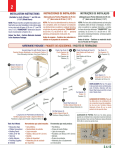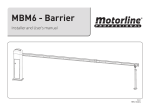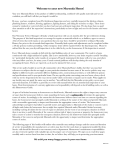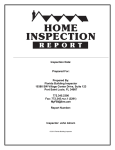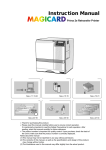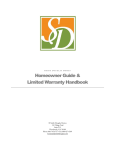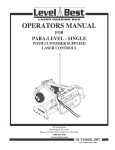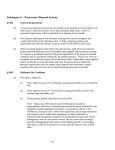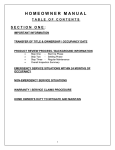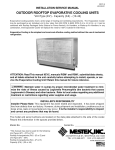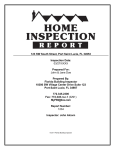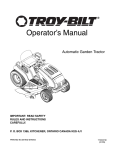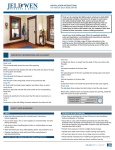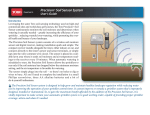Download TABLE OF CONTENTS
Transcript
Rob Roy royrroytoptrp yWillowPlac e Homeowner’s Handbook Overview of Warranties Lexington Village at Rob Roy L.L.C. TABLE OF CONTENTS YOUR NEW CONDOMINUM HOME Condominium Common Elements and Warranty Condominium Common Elements Inspections PRIOR TO CLOSING ON YOUR NEW HOME Quality Assurance Program Pre-Drywall Orientation for your individual home New Home Orientation for your individual home Closing Procedures for your individual home CUSTOMER CARE PROGRAM Manufactures’ warranties’ – for your individual home Extended warranties – for your individual home How to obtain customer care - for your individual home How to obtain customer care – for common elements One month customer care request - for your individual home Ten month customer care request - for your individual home Structural warranty request for common elements In home review for your individual home Customer Care department hours PRODUCT INFROMATION AND HELPFUL HINTS Appliances Brass Hardware Cabinets and Vanities Carpeting Caulk (interior) Ceramic & Marble Tile Countertops (Laminate) Cultured Marble Vanity Tops Doors Toilets Drywall (Walls and Ceiling) Electrical System and Fixtures Fiberglass Tubs & Showers Fireplaces Garbage Disposal Heating, Ventilation & Air Conditioning PRODUCT INFO AND HELPFUL HINTS (cont) Painting (Interior) Plumbing System & Plumbing Fixtures Water Heaters Resilient Floor Covering Smoke Detectors Stainless Steel Sinks Sump Pump / Ejector Pump Thermostat Whirlpool Tubs Windows & Sliding Glass Doors Wood Flooring Wood Trim (Interior) CONDOMINIUM COMMON ELEMENTS Siding Asphalt Drive Balconies Caulk (Exterior) Concrete Foundations, Drives, Walks, Patios Steps, Basement and Garage Floors Gutter and Downspout System Landscaping Package Masonry Overhead Garage Doors Painting (Exterior) Roofing Wood Trim HELPFUL HOMEOWNER INFORMATION GLOSSARY OF TERMS EMERGENCY PROCEDURES What is an emergency? EMERGENCY PHONE NUMBER LIST When you’re unable to reach your warranty contractor Lexington Village at Rob Roy L.L.C. Customer Care Contacts Emergency Bills Your New Condominium Home Condominium Common Elements and Warranty At Rob Roy, you own your home individually and you have an undivided interest in the Common Elements of the Condominium. Some examples of the Common Elements would be the land, building foundation, structural portions of the buildings, and exterior finish materials of the buildings (roof shingles, trim, paint, siding, and masonry), sidewalks driveways, landscaping, fences, playground equipment, and mail stations. The warranty coverage for Common Elements is for the same time period as similar items in individual homes; and, the Warranty is issued to the Condominium Association. Usually a professional Managing Agents is responsible for the management and maintenance of the Common Elements of the Condominium Association and the enforcement of the Warranty. The information presented in the Homeowner Handbooks is intended to summarize your ownership in the Condominium Association and the Warranty provided for your home and the Common Elements. Please review the following documents for more information: RWC 10 year Home Buyer Warranty Declaration of Condominium Ownership and of Easements, Restrictions, Covenants and by-laws for Lexington Village at Rob Roy L.L.C. Condominium Association. Condominium Common Elements Inspections The Common Elements are inspected at predetermined times with the Managing Agent. Landscaping is inspected immediately after installation for compliance with the overall landscape plan. Watering and maintenance of landscaping, as necessary, is a Condominium Association responsibility. Replacements, missing plants or undersized plans are corrected to conform to the landscape plan. One growing season after the initial planting, the landscaping is inspected again, and plants that do not survive the winter are replaced. The building exterior and driveways are inspected when a building is at least half occupied. One year later, the buildings are inspected again for any remaining Customer Care adjustments. Common Elements, not within a Condominium Building, will be inspected when installed and again one year later. As a Homeowner, if you are aware of Common Elements requiring Customer Care adjustments, notify your Managing Agent; they are responsible for coordinating the maintenance and management of the Common Elements. Prior to Closing on Your New Home Quality Assurance Program During the entire construction process, your new home has had periodic inspections by our Construction and Quality Assurance Staff to ensure our high standards are met by our subcontractors. Every feature of your home has been inspected by our unique program, and we take pride in delivering this quality built home to you. Pre-Drywall Orientation for Your Individual Home Before the drywall is installed in your home, you will have the opportunity to see the quality of the carpentry and mechanical components of your home. We will also explain the quality of the exterior features of your home and answer any questions you may have. New Home Orientation for Your Individual Home The New Home Orientation is your pre-occupancy and acceptance review. Our Closing Officer will contact you to schedule this appointment, which will be conducted by your Customer Care Manager. Please meet your Customer Care Manager at your new home to begin your review. Only parties who will be the owners of the property will be permitted at this appointment to review the home. If you feel it necessary to have someone inspect your home, at your cost, please arrange this after your closing. Your Customer Care Manager will review with you the purpose and intent of our New Home Orientation form. At the conclusion of the orientation, you will be asked to sign it, indicating your agreement that any adjustments needed are documented on this form. During this orientation, your Customer Care Manager will familiarize you with the operation of all appliances and normal homeowner maintenance. Please be aware that The Builder will not be responsible for any items of a cosmetic nature not noted on this inspection. These cosmetic items include, but are not limited to: breakage, cracks, chips, scratches, or marks on such items as tile, woodwork, cabinets, mirrors, walls, porcelain, ceramic, glass, plumbing fixtures, laminate countertops, cultured marble tops, fiberglass products, lighting fixtures, doors or appliances. Therefore, please pay special attention to these details at your orientation, and make sure they are noted on the New Home Orientation Form. After you and your Customer Care Manager sign the New Home Orientation Form, retain a copy for your records. To help obtain efficient service, it is always helpful for you to have this form handy to check items off as they are completed. Closing Procedure for Your Individual Home Once the New Home Orientation is completed, you then proceed to the title company for your scheduled closing appointment. After your closing has completed, return to the Sales Office with a copy of your Key Release Letter (received at closing) and the keys for your home will be given to you. KEYS WILL NOT BE RELEASED UNDER ANY CIRUMSTANCES WITHOUT THE KEY RELEASE LETTER Customer Care Program This Homeowner Handbook provides you with important information concerning your new home, and details the Warranties that come with your home. You should get familiar with it very carefully before your New Home Orientation, so that you can prepare any questions you may have regarding this coverage, and will know from the onset which areas are our responsibility, and which areas are your responsibilities. Manufacturers' Warranties The Builder assigns to the purchaser all rights under manufacturer's warranties for appliances and items of equipment included in the home for one year or the manufacturer's written warranty, whichever is less. Homeowners are responsible for registering appliances and equipment with the manufacturer's by completing and mailing manufacturer warranty cards. Extended Warranties Many items in your home are warranted by the manufacturers, beyond the Warranty. Please, review all manuals and warranty information delivered to you at your New Home Orientation for details and the procedure for warranty registration. Obtaining Customer Care for Your Home At the time of your New Home Orientation, your Customer Care Manager will provide you with your Customer Care Request forms. You will then be instructed on how to correctly fill them out. This convenient form helps you list the Items to Be Repaired, Description of Repairs Needed, and the Room Location for each request. These forms should be used to request any service to which you are entitled under the Warranty. When completed, the form must be mailed to the Customer Care Department address provided in this handbook. Due to the number of homes closes during any period and as required by the Warranty, ALL SERVICE REQUESTS MUST BE SUBMITTED IN WRITING. This can be done either by filling out a service ticket and dropping it by the Customer Care Center on site, by sending an email to the Customer Care Dept., or through the company’s website. Except in the event of emergencies, verbal messages, telephone calls or notations on anything other than our "Customer Care Request" forms will not be accepted. The Warranty Service Department wants to respond to your service requests, and therefore, must have them in writing to avoid misplaced notes, errors in verbal communications, and delays in messages not reaching the appropriate person(s) to correctly process your requests. In the event you run out of the Customer Care Request forms or are unable to locate them, additional forms can be requested at any time by writing to the Lexington Village at Rob Roy L.L.C. Corporate Office. Please keep in mind the Customer Care Program covers defects and/or incompletions as explained in this manual. It does not cover items that fall under the heading of normal homeowner maintenance, nor for any items not specifically covered by your Warranty. Obtaining Customer Care for Common Elements All requests for service of any item pertaining to any common elements is done by notifying the Managing Agent, either in writing to the address provided at your New Home Orientation, by email to the email address provided, or by phone at the number on the Emergency Phone Number list in this handbook. One Month Customer Care Request There may be items requiring service, under the Warranty, which come to your attention during the first one (1) month period of living in your new home. We ask that you please wait the full month before notifying us of any non-emergency service. This allows us to better coordinate your Customer Care requests, and create less inconvenience for you. We have found that this eliminates needless repeat trips for our tradesmen and wasted time on your part making your home available for completion of the Customer Care adjustments. Please mark the appropriate box for "1 MONTH CUSTOMER CARE REQUEST" on the Customer Care Request form, fill out the remainder of the form, as per the instructions given at your New Home Orientation, and mail the request to: Lexington Village at Rob Roy L.L.C. 1731 N. Marcey St. Suite 200 Chicago, IL 60614 Attn: Customer Care Department We will then contact you to review the items listed on the Customer Care Request. Eleven Month Customer Care Request Once your New Home Orientation and One Month requests have been completed, if additional Customer Care is required, under the Warranty, please record the item(s) on the Customer Care Request forms provided, and hold this request form until eleven months after your occupancy review date. Then mail it to the above address. Again, this gives you time to organize your requests, which we can then act on collectively. This also allows for an even flow of Customer Care requests from our homeowners into the Customer Care Department throughout the year, allowing us to provide you more effective Customer Care. When we receive your request, we will contact you to review items listed on the Customer Care Request. Structural Warranty Request for Common Elements All Structural Customer Care Requests, under the Warranty, should be directed in writing to Lexington Village at Rob Roy L.L.C., Attn: Customer Care Department to the address above. If after examining the Warranty, a homeowner believes they have a structural defect claim, please notify us in writing. Such requests must be sent to our address, Attention: Customer Care Department. Review of Your Home Shortly after receiving your Customer Care Request, we will contact you to set up an appointment to meet with your Customer Care Manager in your home. During your In Home Review, you will review with your Customer Care Manager, each of the Warranty areas as detailed on your Customer Care Request, along with any items you may have discovered since submitting your form. Through this In Home Review, we will be able to correctly determine the nature of any Customer Care needs, under the Warranty, the specific subcontractor who will be responsible for its correction, and the exact method of repair we are authorizing. No actual repairs will be made at this time. In Home Review Form An In Home Review form is The Builder ’s written authorization to our individual subcontractors to perform your Customer Care work. You will be given a copy of this form at the review, by your Customer Care Manager. Please review this form with your Customer Care Manager to ensure all information is accurate before signing at the top, certifying your agreement. A copy of this form will be given to the subcontractor, as his Customer Care Order, with his responsibilities highlighted. Once the subcontractor has performed the work, he will ask you to sign his work order. When all items on the form are complete, your Customer Care Manager will return and request your signature on the original copy. Once this form has been signed at the top, it cannot be altered. If new items result from any work performed or any new Customer Care requests are reviewed, a new form must be filled out. DO NOT MAKE, NOR RELY ON ANY VERBAL AGREEMENTS FOR SERVICE. Make sure, for your protection; all agreements are memorialized, either in writing or by email. Please don’t assume people working in your home will verbalize any directives to the builder. Please do so yourself in writing. Customer Care Hours of Operation Monday through Friday, 8:30 am to 3:30 pm. Closed on Holidays. Normal service calls will be made by our subcontractors at your home Monday through Friday, between the hours of 8:30 am and 3:30 pm. Unfortunately we cannot schedule nonemergency service calls on evenings, weekends or holidays. Please DO NOT CALL the Customer Care Department UNLESS: You have an EMERGENCY in your home (See section “What is an Emergency?”) You have a questions regarding work which has already been authorized, (i.e., a Customer Care Order has been issued); You have read your various service manuals and you have a question regarding specific warranty coverage All non-emergency service requests must be submitted either in writing at the Customer Care Center, or by email at “[email protected]” Product Information and Helpful Hints Kitchen Appliances Product Information Any specific product information you require on your new appliances should be obtained by reviewing the individual service manuals provided to you at your New Home Orientation. Fill out and mail the warranty cards as instructed. Helpful Hints In the event you require service on any of your new appliances, please contact the appliance company directly to arrange for an appointment. For individual appliance service phone numbers, please see the EMERGENCY CALLS ONLY list provided to you at your walk through. There may be occasions when you are unsure if the problem should be resolved by the appliance company or the installer. In these situations, contact your Customer Care Manager to determine responsibility. Before calling for service, always try to determine if the problem lies elsewhere. (Example: check breakers for electrical appliances, or be sure the gas is on for gas appliances.) Manufacturer's Warranty The Builder assigns you, the purchaser, all rights under the manufacturers' warranties for appliances and items of equipment included in your home. Limitations to the Manufacturer's Warranty include: Visible damage not noted on the New Home Orientation Any and all appliances purchased and installed by parties other than a Builder's Agent Hardware Product Information Quality hardware has been used throughout your home. Lock trim is factory-treated with a clear protective coating, electrostatically applied to provide both durability and beauty. However, it may gradually tarnish and take on a discolored appearance over time. Helpful Hints Initial care requires periodic cleaning with mild non-abrasive soap and light buffing with a soft cloth. Normal usage may loosen screws that secure the hardware to the door. Periodic checking and tightening is homeowner maintenance. Warranty All hardware is warranted to be free of defects in material and workmanship for one year after closing. Limitations to the Warranty include: visible damage not noted on New Home Orientation normal usage wear and tear including tarnishing loosened screws which secure hardware tarnished surfaces or pitting from exterior elements Cabinets and Vanities Product Information The kitchen cabinets and bathroom vanities used in your home are affected by changes in temperature and humidity and therefore, may contract or expand with weather changes. In the event you do experience shrinkage and swelling, it will be more evident in the cabinet and vanity doors. Helpful Hints Wood cabinets and vanities are factory-finished and should be cared for much the same as fine wood furniture. You may enhance and preserve the rich wood grain finish by a periodic application of paste wax. Cabinets and vanities with laminate surfaces require very little maintenance; they can be cleaned with a moist cloth. Scratches, which may result from normal use, can usually be touched up with a wood tone, touch-up crayon, which can be purchased at any hardware store. Cabinet and vanity hardware will loosen with repeated use. You should periodically tighten the hardware as needed. For any warpage problems, please notify the Customer Care Department on a Service Request form at your next Customer Care period. We will then inspect for warpage. Warranty Kitchen cabinets and bathroom vanities are warranted to be free of defects in material and workmanship as listed in the Warranty Standards. Limitations to the Warranty include: Visible damage not noted on the New Home Orientation Carpeting Product Information The floors in the primary living areas of your home have been covered with professionallyinstalled carpeting, per your selection. All carpeting comes from the mill in standard twelvefoot widths. Every effort has been made to limit the number of seams and locate them as unobtrusively as possible. However, seaming is unavoidable. Some grades, brands or colors of carpet may show seams more readily than others, but this is not necessarily a reflection of the quality of carpet you have chosen. After the initial installation of the new carpet, you will notice excess yarn will appear on the carpet surface this is normal. Do not be concerned, this will dissipate with repeated vacuuming. Helpful Hints Following these useful maintenance tips will help your carpet remain beautiful: Have your carpet professionally cleaned. The frequency of cleaning depends on the type of yarn, color and the traffic the room receives. You should consult a carpet supplier for information on specific types of stains before attempting any type of spot removal. Consult with the carpet manufacturer if you intend to shampoo your carpet using water. Some manufacturers will advise against this procedure. Be careful moving heavy furniture. Pushing heavy furniture may stretch the carpet and cause 'bubbles" to appear. Warranty The carpeting in your home is warranted to be free of defects in material and workmanship as listed in the Warranty Standards. Limitations to the Warranty include: Spots, discoloration or damage not noted on the New Home Orientation Precise matching of your carpet to the carpet sample, due to varying dye lots, cannot be controlled by The Builder. Unavoidable visible seams Any and all carpeting purchased and installed by parties other than a Builder's Agent Caulk (Interior) Product Information Interior caulking has been applied around tubs, sinks, tops, thresholds, and trim materials. Even properly installed caulking will shrink and show surface cracks due to settlement, expansion, and contraction. Helpful Hints It is recommended that you check the interior caulking around the house once a year and recaulk as necessary. The quality of caulk is very important when choosing a brand to maintain your home. Generally, the silicone caulks are superior and longer lasting. Some are paintable and others are not. Warranty Joints and cracks in exterior wall surfaces and around openings shall be properly caulked to exclude the entry of water. The Builder will recaulk joints and cracks in exterior wall surfaces as required to correct leakage only once during the one year warranty period. Limitations to the Warranty include: Visible damage or shrinkage not noted on New Home Orientation Minor surface cracks, as listed in the Warranty Standards Interior caulking will not be recaulked unless noted on the New Home Orientation Ceramic & Marble Tile Product Information The ceramic/marble tile used in various rooms of your new home provides a durable and decorative covering for the floor(s) and wall(s). Cracks in grouting of ceramic tile joints are common due to normal shrinkage conditions. Shade and/or color variation is inherent in all fired clay products and grout. Marble is a product of nature and not a man-made product. Helpful Hints Abrasive cleansers should not be used to clean tile surfaces, as this may result in surface scratches. To remove particularly heavy accumulations of film from glazed tile, you may need a stiff brush and mild cleanser. A special sealer for grout will make it more stain resistant. Staining agents should be mopped up promptly, even though they rarely affect ceramic tile. Care should be taken to avoid damage to the tiles by securing bath fixtures too tightly to bath walls and/or dropping heavy objects on ceramic or marble surfaces. Such occurrences can result in cracked and broken tiles. Warranty All ceramic tiles in your home are warranted to be free of defects in material and workmanship as listed in the Warranty Standards. Limitations to the Warranty include: Visible damage such as cracks, chips, scratches not noted on the New Home Orientation Any and all tile purchased and installed by parties other than a Builder's Agent Variations of color, veining and surface textures in marble Counter Tops (Laminate) Product Information The laminated counter tops used in your home are made of a durable material which is heat and scratch resistant. However, this material is NOT HEAT OR SCRATCH PROOF. Helpful Hints Do not put hot pans directly on your counter tops, use trivets or asbestos lined hot pads. Failure to do so will cause damage to the laminate surface. The cuffing, slicing and dicing of food directly on the counter top will result in damage to the surface. Always use a cutting board for this type of food preparation_ Do not use abrasive cleansers when cleaning your counter top. Use of such cleansers may cause damage to the surface. A damp cloth should take up any normal residue on your counter top. Warranty Counter tops are warranted to be free of defects in material and workmanship for one year after closing. Limitations to the Warranty include: Visible damage not noted on the New Home Orientation Burn marks, raised surface areas, etc. resulting from the placing of hot pots, pans, cigarettes, etc. on the unprotected surface Dull surface due to use of abrasive cleansers Seams that delaminate or separate as a result of excessive moisture related surface exposure Cultured Marble Vanity Tops Product Information The cultured marble vanity tops used in your home are much like natural marble and must be cared for properly. Helpful Hints Use only mild liquid cleaning agents to clean marble vanity tops. Any good spray or paste wax will keep the shine. DO NOT USE ANY TYPE OF ABRASIVE cleansers to clean this surface; they will cause scratching and dulling of the surface. Do not place cigarettes or other hot objects on the vanity tops, as the cultured top will stain much like the quarried natural marble. Warranty Cultured marble vanity tops are warranted to be free of defects in material and workmanship for one year after closing. Limitations to the Warranty include: Visible damage not noted on the New Home Orientation Damage arising from the use of abrasive cleansers Damage arising from placing hot objects on the unprotected top Cracks due to dropping objects on the surface Doors Product Information Winter heating may change the moisture content of wood doors, causing temporary warping. Summer humidity may cause sticking doors due to swelling. Interior doors, bi-pass and bifolds often stick or warp due to various weather conditions. Interior panel doors may show raw wood if the panels shrink more than the frame. Exterior doors will warp or bow to some degree due to a temperature differential between inside and outside surfaces. These conditions are normal. Helpful Hints Sticking: If the sticking is caused by swelling in damp weather, fold sandpaper around a wood block and sand the edge that binds. If uneven alignment is the cause, check to see that hinge screws are tight and holding properly. If the door still is out of alignment, sand or plane the edge that binds. Always paint or varnish areas you have sanded or planed to protect the wood from absorbing moisture and prevent further problems. Weather stripping: To maintain a good seal, occasionally you will need to adjust the magnetic and compression weather stripping on your exterior doors. You can do this easily by carefully running a screwdriver firmly up and down the groove in the weather stripping. A well-sealed door should be somewhat hard to open and close. High winds may cause a howling noise. Adjusting as mentioned above will solve the problem, unless the winds are very strong. Painting: Whenever you paint the house or trim, also paint wood or steel exterior doors. Natural finished doors require more frequent re-coating. Adjustable Thresholds: Many exterior doors are equipped with adjustable thresholds. These are easily adjusted as the seasons and humidity change. Bi-fold or Sliding Doors Stick: Keep tracks free of dirt and grit. Occasional application of silicone spray will enable doors to slide easily and prolong the life of your doors. Warranty All doors are warranted to be free of defects in material and workmanship as listed in the Warranty Standards. Limitations to the Warranty include: Visible damage not noted on the New Home Orientation Installation of a separate storm door may void the warranty of the primary door if it has plastic window frames or plastic decorative elements. Drains Product Information Each plumbing fixture in your home has a "J-shaped" drain pipe designed to provide a water barrier between your home and the odor of sewer gas. This trap holds water, which keeps airborne bacteria and the odor of sewer gas from entering your house. Helpful Hints If you seldom use a fixture, turn it on at regular intervals to replace evaporated water and keep the barrier intact. Because of their shape, traps are the point where drains are most likely to become clogged. Bathtubs, Sinks or Showers If a drain in these fixtures becomes clogged, first use a plunger. Be sure the rubber cup covers the drain opening and that the water comes well up over the cup edge. Working the plunger up and down rhythmically 10 or 20 times in succession will build up pressure in the pipe and be more effective than sporadic separated plunges. If the plunger does not solve the problem, use a plumber's "snake". (These can be rented or purchased at a hardware or plumbing store.) Always turn the handle of the snake in the same direction when removing it as you did when inserting it. This will prevent matter attached to the snake from coming loose before the snake is removed. If a plunger or snake can partly open a drain, often hot water will finish the job. If not, open the trap, putting a bucket or pan under it to catch the water. Potash lye or caustic potash may help finish opening a drain, but never use them on a completely stopped up drain. They may take as long as overnight to work, and if you have opened the trap, the chemicals would be a hazard. WARNING: Because potash lye and caustic potash are highly corrosive, always pour them slowly into the drain to keep them from splattering. Never pour water into the chemicals. Wear old clothes, rubber gloves and goggles or safety glasses. Never use a plunger after chemicals have been added to a drain the water may splash and cause an injury or damage nearby surfaces. Follow label directions. Toilets Treatment of a stopped-up toilet is the same, except for the following: The trap is built into the toilet and is less accessible. Instead of using a snake, you must use a coil spring steel auger. (Can also be rented or purchased at a hardware or plumbing store.) Insert the auger so that the point goes up into the trap. Turning the auger's handle will break up the blockage or catch it so it can be removed. PREVENTION: You can avoid stopped-up drains by never pouring grease into a drain or toilet. Ordinary washing soda (not baking soda) added to a drain regularly will keep it free of grease from soap and cooking utensils. Run hot water through the drain, turn off the water, add 3 tablespoons of washing soda and follow with just enough hot water to wash the soda down the drain opening. Let it sit for 15 minutes and then run more hot water. Warranty Drains are warranted to be free of defects in material and workmanship as listed in the Warranty Standards. Limitations to the Warranty include: Visible damage not noted on the new home orientation Drywall (Walls & Ceilings) Product Information The interior walls of your home have been constructed of gypsum wallboard (drywall). Slight imperfections such as shrinkage, settlement cracks, nail pops and/or seam lines do appear during the drying and settling process of your home. This is a normal condition of drywall construction. Helpful Hints No attempt should be made to repair these occurrences in the drywall until your home has gone through the drying and settling period. This is usually complete in about one year. After one year and the house has sufficiently dried, you can use a product called spackle to fill in these areas. Spackle can be obtained in arty hardware or builder's supply store in either powder or paste form. Follow the instructions on the container and then use the touch-up paint which was provided to you at your New Home Orientation. The Builder will return once during the first year of warranty to repair only cracks exceeding 1/8 inch in width (not length) or greater. It’s to your benefit to wait until your 10 Month Inspection to note these cracks for repair. The Builder will repaint only those repairs to the original color. We cannot guarantee color match. Warranty All drywall in your home is warranted to be free of defects in material and workmanship as listed in the Warranty Standards. Items not covered by this Warranty include: Visible damage not noted on the New Home Orientation Electrical System and Fixtures Product Information The electrical system and fixtures in your new home have been installed by a licensed electrical contractor. Each phase of construction has been inspected by your Village and has met all applicable requirements and electrical standards in your area. Helpful Hints Your electrical wiring and appliances are protected by circuit breakers which eliminate the need to replace fuses should you inadvertently overload the system. The wiring in your home will accommodate a number of electrical appliances, however, occasionally you may find an outlet or circuit that does not operate properly. Note: Ordinarily, small appliances may be added without fear of overloading a circuit. However, large appliances and some small appliances may cause tripping of the circuit. Example: The addition of a second refrigerator in the garage. The circuit breakers are located in the main electrical panel box which was pointed out to you during your New Home Orientation. In the event you do not receive power to an outlet, you should first check your main electrical panel box. The breaker which is normally in the "ON" position will undoubtedly appear in the "OFF" position. To restore power, you should reposition it to the "ON" position. Other causes of circuit tripping are: Worn out cords or defective plug connections Defects within the appliances themselves A defective breaker If after resetting the circuit breaker it trips off again, you should immediately locate the cause and correct the problem. At least one wall outlet in most of the rooms in your home is operated by a wall switch. Usually the switch will operate 1/2 of the outlet. (This enables you to have a lamp and clock radio at the same location.) Therefore, if you do not have power to an outlet, check the switch in the room first before checking the breaker panel. Your home is also equipped with ground fault interrupted (GFI) circuit breakers for some kitchen, bathroom, garage and outside receptacles. They are designed to "open" from the slightest moisture contact or short circuit. If you cannot get electric power at one of the receptacles, simply reset the GFI by pressing the reset button. Warranty The electrical fixtures in your new home are warranted to be free of defects in material and workmanship as listed in the Warranty Standards. Limitations to the Warranty include: any visible damage to fixtures not noted on the New Home Orientation any system problems which arise as a direct result of work performed on the system by any parties other than a Builder's Agent light bulbs, including lighted door bells Fiberglass Tubs & Showers Product Information Fiberglass tubs and showers, fiberglass wall surrounds, or fiberglass shower bases may be installed in your home. Helpful Hints Avoid using abrasive cleaners which will scratch the surface Avoid hitting it with sharp objects or dropping objects which may chip or crack it Warranty All fiberglass tubs & shower bases are warranted to be free of defects in material and workmanship as listed in the Warranty Standards for a period of one year after closing. Limitations to Warranty include: Visible damage not noted on New Home Orientation Fireplaces Product Information Your home may be equipped with one of two types of fireplaces: all masonry, or prefabricated. Both types are equipped with a flue damper which you should open before lighting a fire and close between uses. Helpful Hints Be sure the damper is open and the flue is unobstructed before you light a fireplace. Keep the damper closed, however, when the fireplace is not in use so that warm air will not escape in winter. Build a fire on andirons or a grate and not directly on the fireplace brick Avoid burning trash or rubble Never use kerosene, gasoline or other highly explosive liquids to start a fire Store firewood outside because it may harbor insects Be careful when lighting fireplaces with gas log lighters. Use long matches or an extended lighter to ignite the gas. Open the gas control valve slightly to ignite the gas. After the gas is burning, open the valve to the desired setting for gas log sets; or turn off the log lighter gas control valve if natural wood is used, once the logs are burning. To avoid gas build up before ignition, open the damper before igniting the gas starter. Warranty All fireplaces are warranted to be free of defects in material and workmanship as listed in the Warranty Standards. Limitations to the Warranty include: Visible damage not noted on New Home Orientation Wind driven rain down the flue Garbage Disposal Product Information If you have a garbage disposal attached to your kitchen sink, it will probably be one of two types; continuous feed or batch feed with locking cover.The included instructions and warranty material will give precise directions for its operation and service. Helpful Hints Many people assume that because their waste disposal is capable of grinding up most of their garbage, it is also capable of eliminating grease and other substances they would not otherwise pour down a drain. In fact, you should be careful not to clog disposal drains with grease. When grinding greasy substances, use plenty of cold water. Always use cold water when the disposal is on. Should the drain become clogged, do not put chemicals down the disposal. Reset Buttons: Most disposals have a reset button that works in much the same way as a circuit breaker. Should the disposal become overloaded with a substance it cannot grind, it will turn itself off. If this happens, turn the switch off, remove the substance obstructing the disposal's operation, wait about 3 minutes, push the reset button (see your instruction booklet for its location), and turn the switch on. If it still does not start, turn it off again and check to see if you have tripped a circuit breaker. If the circuit breaker has not interrupted the flow of current, reset the circuit breaker and try again. Some disposals come equipped with a special wrench that can be inserted in a hole in the bottom of the disposal (under the sink). Others have a two pronged wrench that fits in the top of the circulating plate. Turning the wrench a couple of times will usually loosen the material enough so that the disposal will start. Avoid putting large amounts of fibrous material (such as banana peels, celery waste or corn husks) down your disposal. Manufacturer's Warranty The Builder assigns you, the purchaser all rights under the manufacturer's warranty for the disposal included in your home. Limitations to Warranty include: Visible damage not noted on New Home Orientation Damage due to foreign objects not designed for the disposal Heating, Ventilation & Air Conditioning Product Information The furnace and central air conditioning system (standard or optional) have been installed by a licensed heating contractor. Each phase of construction has been inspected by your Village and has met the applicable requirements and heating standards in your home. For any specific product information you may require, please read the individual service manuals provided to you at your New Home Orientation. Helpful Hints In the event you find the furnace is not operating or you are not receiving a sufficient amount of heat, you should check: Your circuit breaker. The switch should be in the "ON" position. The electric switch that controls your furnace fan. (Note: The switch will be on or near the furnace in the location pointed out to you during your New Home Orientation.) That the pilot light or the electronic ignition is functioning; refer to the furnace manual for instructions. That all room registers are dampered properly to allow for an even flow of heat If the furnace filter should be cleaned or replaced. This should be done on a regular basis as indicated in the furnace service manual. A dirty filter can stop the furnace from working. Your heating contractor's phone number is located on the furnace and will also be found with the emergency numbers in your warranty literature. By leaving your interior doors open, you’ll have better air circulation throughout your home. Manufacturer's Warranty The Builder assigns you, the purchaser, all rights under the manufacturers' warranties for appliances and items of equipment in your home. The remaining heating and air conditioning items purchased with your new home are warranted to be free of defects in material and workmanship as listed in the Warranty Standards. Limitations to the Warranty include: Visible damage not noted on the New Home Orientation Any system problem(s) which arise as a direct result of work performed on the system by any parties other than a Builder's Agent Painting (Interior) Product Information Your walls and ceilings have been painted with an interior latex paint. Helpful Hints Touch-up paint for your interior walls, ceilings, and interior trim, will be provided at the time of your New Home Orientation. For those who wish to wallpaper after your first year, you must prepare all painted surfaces for wallpapering with an appropriate sizing material. This product can be purchased at any wallpaper, paint or hardware store. Follow instructions on the container. Note: Failure to prepare your walls could result in the paper not adhering to the surface and create the possibility of the paper pulling the paint or the drywall surface material off the wall. Warranty All interior painting is warranted to be free of defects in materials and workmanship as listed in the Warranty Standards. Limitations to the Warranty include: Visible damage to painted surfaces not noted on the New Home Orientation Restoration of painted surfaces to the original surface finish supplied with your home. (If you repaint or paper a wall during your first year warranty period which is subsequently repaired under this warranty, The Builder will not assume responsibility for restoring the wallpaper or any special paints you, the homeowner, may have used.) Plumbing System & Fixtures Product Information The plumbing system and fixtures in your home have been installed by a licensed plumbing contractor. Each phase of construction has been inspected by your Village and has met all applicable requirements and plumbing standards in your area, including the requirement for the water-saver features for all residential plumbing fixtures. Toilets Water-saver toilets do not have the same flushing capability, which you may be accustomed to, due to their design to use less water. Never flush hair, grease, lint, diapers, rubbish, etc. down the toilet drain. These wastes will clog drains and sewer lines. Cleaning: Many commercial products are available for toilet cleaning. Use them as directed, but do not mix them or use then with household bleach or other cleaning products. Only use them in the toilet. Toilet Leaks: If the water chamber seems to be leaking, the dripping may be coming from condensation on the outside of the tank. If this is a problem, you may want to use a cloth tank cover. If water leaks into the bowl through the overflow pipe, try bending the rod that holds the float so that the float is closer to the bottom of the tank. Flush the toilet, and if it still leaks, you will probably have to replace the inlet valve washer. If the water trickles into the bowl, but is not coming through the overflow pipe, it is coming through the flush ball valve. The rods between the ball valve and the flushing handle may need aligning so that the ball drops straight down after the handle has been pushed. Water will leak through into the bowl if the ball valve is worn or if there is dirt or rust on the ball or ball seat. If the latter, remove dirt and rust. If the ball valve is worn, turn off the water, unscrew the ball and replace it with a new one Faucets Because they have moving parts, faucets are more likely to require repair from time to time than plumbing with no moving parts. Aerators: To maintain your faucets, you will need to clean the aerators every three or four months. This attachment to the faucet adds air to the water to reduce splashing and reduce water use. Faucet Leaks: If a faucet leaks, usually you can fix it by replacing washers. Instead of washers, some new single-control faucets for hot and cold water have cartridges, which last longer, but still must be changed. Be sure to tarn off the water at the shut off valve before repairing a faucet. Exterior Faucets: Also, be sure to remove any garden hoses from the exterior sill cocks and turn the faucet off prior to temperatures falling below 32 degrees. Failure to do so will cause damage to the frost-roof type sillcock as the frozen water in the hose will be forced back into the faucet as it expands. State law requires these frost-proof sill cocks to have a back flow prevention device to avoid foreign matter from entering the fresh water supply. Plumbing Your plumbing has been professionally installed and if properly cared for should serve you well for many years, To avoid costly major repairs, promptly repair minor problems immediately. Leaks: Copper pipes and PVC pipes should last the life time of the house. If your washing machine, dishwasher or other water using appliances seem to be leaking, check the trap to see that the drain is not clogged. (See also "DRAINS.") Noisy Pipes: Can be caused by a variety of problems. Most common are a weak washer, a loose faucet part and trapped steam in a hot water pipe. Correct the cause immediately to avoid vibrations created by the noise. A strong vibration can cause fittings to loosen and leak. Water Heaters All hot water heaters have a control mechanism to govern water temperature. Set gas water heater temperature controls to NORMAL. Do not store anything near the heater, because it may block air flow and create fire hazard. Your water heater requires little maintenance to operate efficiently. Most manufacturers recommend draining them once a year. The directions for this are usually on the side of the hot water heater. If the pilot light on the gas heater goes out, refer to the water heater manual for instructions on relighting. Manufacturer's Warranty The Builder assigns you, the purchaser, all rights under the manufacturers' warranties for appliances and items of equipment in your home. The remaining plumbing items in your home are warranted to be free of defects in material and workmanship as listed in the Warranty Standards. Limitations to the Warranty include: Visible damage to the plumbing system fixtures not noted on the New Home Orientation Any system problems which arise as a direct result of work performed on the system by any parties other than a Builder's Agent. Resilient Floor Covering Product Information The resilient floor covering used in your home is a no-wax flooring. You may experience conditions with your new floors such as raised nail heads, tiles lifting or seams separating. Raised nail heads are caused by movement of the floor joists due to shrinkage and deflection. The Builder has attempted to minimize this problem by using special nails and gluing the subfloor to the joists to minimize the number of nails used. Separation at the seams is caused by shrinkage; and the lifting of a tile is sometimes caused by failure of the adhesive material in a particular area. Helpful Hints Asphalt compounds tracked from drives can permanently stain resilient flooring. Mats placed at doors will minimize this. Some rubber backed mats can cause the floor to discolor in time. Resilient flooring includes linoleum, asphalt, vinyl and rubber. Care for them daily by removing loose dirt with a broom, dust mop or vacuum. Wipe up spills immediately. If a spot dries, use a damp sponge, cloth or mop. Occasionally damp mop the floors between cleanings. When floors are dull and cannot be refurbished by mopping, clean them thoroughly with a good detergent. Use floor protectors on legs of furniture to minimize scratches and indentations. Floor finish or wax provides hard films that don't smear, but also do not respond to buffing. Waxy polishes leave softer films with slightly lower gloss that can be buffed to restore appearance. Apply wax moderately. The right amount is the least that can be used without streaking. Let it dry for 30 minutes before allowing traffic. Once or twice a year, use a remover to take off the build-up of old polish or wax. Dilute as recommended, apply, rinse, let dry, and then apply a new coat of polish. High heels will damage all resilient and sheet vinyl floors. Warranty The resilient floor coverings are warranted to be free of defect in materials and workmanship as listed in the Warranty Standards. Limitations to the Warranty include: Visible damage not noted on the New Home Orientation Any damage to floor due to improper care or use, such as: improper maintenance, improper use of caustic cleaning agents, and failure to use recommended floor protectors and furniture rests under furniture and appliances. Any and all floor covering purchased and installed by parties other than a Builder's Agent. Smoke Detectors Product Information Smoke detectors have been installed in accordance with your municipal building codes. Helpful Hints Keep fans and drafts away from the detector as the dust particles may set them off. Run the range hood fan when cooking to avoid heat/smoke setting it off. Change the battery when the detector emits a "chirping" sound. This means the battery is low. (Most detectors require a nine-volt battery.) Manufacturer's Warranty The Builder assigns you, the purchaser all rights under the manufacturer's warranty for the smoke detectors in your home. Limitations to the Warranty include: Visible damage not noted on the New Home Orientation Short-out or burn-out due to lightning or electrical surge Stainless Steel Sinks Product Information A stainless steel sink may be a feature in your home. This sink should give you years of satisfactory service, but it does require regular maintenance to enhance its shine and luster. Helpful Hints Rubber Mats: Due to the resiliency of stainless steel, rubber mats are not essential to protect your sink, glassware, dishes, and are therefore not recommended. Residual water deposits and food particles trapped underneath rubber mats could cause discoloration. Discoloration: Pitting and Rust: Can be caused by wet sponges, clothes, cleaning pads and rubber mats left on the sink surface. Steel Wool Pads: Should never be used to clean your sink. Iron particles imbedded in the grain lines from these pads can cause rust and pitting of the sink surface. Liquid Soap: Most liquid detergents contain chemical additives which will affect the original shine of the finish if left to dry on your sink. In some instances, full strength residual liquid detergents have caused pitting and staining of the sink surface. Bleaches: The chlorides in bleaches can react with your stainless steel sink and cause corrosion. They should not come in contact with the surface of the sink for extended periods. If they are used, rinse thoroughly. If clothes are left in the sink to soak, bleaches may cause rusting and pitting at the water line. Spotting: Water quality can also affect the appearance of your sink. Where hard water or water with high iron content is present, a brown stain may appear, giving the appearance of rust. In areas with water of a high concentration of minerals, or over softened water, a white film may appear on the sink. We suggest the sink be towel dried after each use if this condition exists. Warranty The stainless steel sink is warranted to be free of defects in workmanship and material for one year after closing. Limitations to the Warranty include: Visible damage not noted on the New Home Orientation Stains due to water quality or improper use Sump Pump/Ejector Pump Product Information If you have a basement in your home, a sump pump is normally installed to pump storm water into the yard and away from the home. A separate ejector pump is installed to pump waste water from the basement floor drain into the sanitary system. Helpful Hints A sump pump pit should be checked to ensure it remains clean of debris such as pebbles. If a washing machine discharges through the ejector pump, be aware lint may plug the pump. You must provide the necessary maintenance of removing the lint from the pump intake screen and sump pit. The ejector pump installed in your home is for liquid waste only. You must change the pump to accommodate solid waste if you add a bathroom in the basement. If you have valuable possessions in the basement, it would be advisable to add a battery powered back up sump pump in case of electrical power loss. Manufacturer's Warranty The Builder assigns you, the purchaser, all rights under the manufacturer's warranty for the sump pumps in your home. Limitations to the Warranty include: Visible damage not noted on the New Home Orientation Consequential damages if the sump pumps become inoperable Recycling caused by not extending or maintaining the water discharge area Thermostat Product Information The standard thermostats are of good quality and require no maintenance. You may have an optional night set-back thermostat for which you have been supplied an instruction manual. Helpful Hints Read instructions carefully. Properly set, these thermostats will save you money! Manufacturer's Warranty The Builder assigns you, the purchaser, and all rights under the manufacturer's warranty for the thermostat in your home. Limitations to the Warranty include: Visible damage not noted on the New Home Orientation Whirlpool Tubs Product Information Your optional whirlpool tub has been designed to give you years of satisfying relief from aches, tensions and fatigue. When the whirlpool system is activated, water is drawn from the tub through a suction line to the pump where it is pressurized and discharged back into the tub. Induction of air into the water stream creates the turbulence and is controlled by the air control knob on the side of the tub. Helpful Hints Never operate the pump without sufficient water. Consult a physician if you are pregnant, or suffer from heart disease, high blood pressure or diabetes. Excessive long hair may obstruct the water returns. The timer was deliberately placed out of reach to prevent injury. Draw your bath at least 1" above the jets and do not exceed 104 degrees Fahrenheit. Clean and disinfect system every one to two months depending upon usage. Fill tub to operating level with lukewarm water, add 1 cup of liquid chlorine bleach. Turn the system on for 10-15 minutes, drain and wipe dry. Never use abrasive cleaners. Do not use bubble bath or oil in the water when the whirlpool is operating. Manufacturer's Warranty The Builder assigns you, the purchaser all rights under the manufacturer's warranty for the whirlpool tub in your home. Limitations to the Manufacturer's Warranty include: Visible damage not noted on New Home Orientation Damage or malfunction due to accident, freezing, negligence, improper use, or care Windows & Sliding Glass Doors Product Information The aluminum, vinyl, or wood windows, and sliding glass doors used by The Builder are selected due to their high energy efficiency rating standards. Windows, of course, are a source of heat loss and you may feel cold radiating from a properly installed and functioning window. Helpful Hints Due to the fact that you live in a modern energy-efficient home, you may experience ice build up on windows when you have a combination of cold weather and high humidity. This is a common occurrence, and does not necessarily indicate a defect in the window or its installation. By reducing the humidity level in the house, you will reduce and possibly eliminate this situation. If you are experiencing an extreme ice build-up on your windows, you should definitely investigate your humidity level in the home. Water damage due to over humidification is expressly excluded from your one year warranty coverage. Keep all window sill channels and sliding glass door tracks free of dirt and particles to allow proper seal and operation. In the event you feel a draft from your sliding glass door or window(s), make sure to check the track for build up of dirt before requesting Customer Care. To ensure proper drainage, windows and sliding doors, are equipped with small drain openings, at the base of the frame, called "weep holes." You should periodically check the weep holes in windows and doors to make sure they are free of dirt. If you find that you have an abnormal draft from a window or door, please contact the Customer Care Department. We will investigate the problem and take corrective action, if required. Please note that some drafts are inevitable. Warranty Windows and sliding glass doors are warranted to be free of defects in material and workmanship as listed in the Warranty Standards. Limitations to the Warranty include: Visible damage to glass, screens, etc., not noted on the New Home Orientation Damage due to over humidification of the home by the homeowner Wood Flooring Product Information You may have selected a prefinished parquet, strip or plank floor. Some characteristics of these products are: streaks, spots and color variations an occasional unfilled pinworm hole not over 1/16" in diameter Warranty All wood flooring in your home is warranted to be free of defects in material and workmanship as listed in the Warranty Standards. Limitations to the Warranty include: Visible damage not noted at the New Home Orientation negligence, improper or lack of maintenance cracks, and voids caused by normal settlement, expansion or contraction; or due to atmospheric conditions (humidity, dampness, heat, or cold) Wood Trim (Interior) Product Information Like other organic materials, wood is affected by heat, cold and extreme humidity, and therefore may contract or expand with weather changes. As a result, minor shrinkage and swelling of interior wood trim elements is unavoidable. The primary areas which may be affected include doors, baseboards, wood floors, handrails, fireplace mantles, paneling and shelving, and result in slight cracks around doorways, arches, windows., joints in door casings and nail pops around baseboards. Although it is impossible to completely alleviate the problem, keeping the house at even temperature and humidity levels is an excellent precautionary measure. Helpful Hints When cleaning any wood trim, make sure to use only a clean dry dust cloth. Use of water or chemical cleaners may affect some finishes. All interior wood trim is warranted to be free of defects in material and workmanship as listed in the Warranty Standards. Limitations to the Warranty include: Visible damage not noted on the New Home Orientation Condominium Common Elements Siding Product Information The exterior siding materials for your home have been selected for durability, appearance and ease of maintenance. Helpful Hints Routine cleaning (once a year) will keep your siding looking new, as well as extend its life. Avoid vigorous rubbing and hard objects hitting siding (rocks thrown by a lawn mower or baseballs thrown against siding). Hard-to-remove stains (Example. tar or grease.) should be removed according the manufacturers maintenance and cleaning instruction. Warranty Your siding is warranted to be free of defects in material and workmanship for a period of one year after closing. Limitations to the Warranty include: Visible damage not noted on New Home Orientation Damage, loosening, etc., due to abnormal weather conditions (Example: hail, ice storm, excessive winds.) Siding damage from winds in excess of 50 miles per hour. Asphalt Drive Product Information For those homeowners who may not have their asphalt drives in at time of move-in, due to the season in which they closed, all exterior work will be completed in the spring, when weather and soil conditions permit. The asphalt plants normally open for the season between April 15th and May 1st. A gravel base will be put down in the interim period. You will undoubtedly experience some settlement when the ground thaws that will be regraded when the final drive is installed. If you experience extreme settlement that hinders your ability to use your drive, call your Customer Care Manager, who will arrange for more gravel. Expansion and contraction cracks are unavoidable due to asphalt being subject to soil and temperature conditions. This is especially noticeable in our northern climate where changes are extreme. Your best protection is to apply a quality seal coat material at least once a year. Freeze and thaw cycles may also create localized pockets which may periodically not allow complete drainage. This condition is unavoidable due to climate. Helpful Hints Asphalt is a very porous substance and in order to properly care for your new drive, we suggest you abide by the following: DO NOT drive on the asphalt surface for at least two days after installation. This will, of course, include any moving vans or heavy vehicles at any time. DO NOT park on the asphalt surface for at least four days after installation. Normal traffic from the street to the garage is harmless after the initial waiting period; asphalt drives are not designed to support heavy vehicles such as moving vans. DO NOT park continuously on the same spot on the asphalt surface during the first hot summer. This will cause depressions which collect water and cause premature deterioration during freezing and thawing cycles. DO NOT spill gases or oil on the asphalt surface since these substances can cause the asphalt material to soften and disintegrate? DO exercise care with bicycle kick stands, chairs, ladders, car jacks and even high-heeled shoes, as any sharp projection will cause indentations. DO install edging between asphalt and grass to prevent roots growing into asphalt. Warranty The Builder will repair only the visibly damaged portions of driveway surfaces which are noted on the New Home Orientation. Limitations to the Warranty include: Visible damage not noted on the New Home Orientation Minor settlement of drive areas "Raveling" of asphalt edges next to landscaped areas Balconies Product Information Balconies are constructed with pressure-treated and cedar lumber to resist deterioration due to exposure and weather conditions Helpful Hints The balcony wood deck should not be covered with outdoor carpeting or any other materials that would prevent standing water from draining off the deck. The life of the balcony will be extended if snow and/or ice are not allowed to remain on the balcony for extended periods. Warranty Balconies are warranted to be free from defects in material and workmanship for one year after closing. Limitations to the Warranty include: Visible damage not noted on the New Home Orientation or a Common Elements Inspection Damage or deterioration of the balcony resulting from the addition of materials that "trap" water or moisture on the balcony Damage or deterioration of the balcony from failure to remove snow and/or ice Caulk (Exterior) Product Information Caulking has been applied to your home around doors, windows, exterior vents, sill cocks, air conditioning line, gas piping and where siding abuts brick or wood. Even properly installed caulking will shrink and show surface cracks due to settlement, expansion and contraction. Warranty Joints and cracks in exterior wall surfaces and around openings shall be properly caulked to exclude the entry of water. The Builder will recaulk joints and cracks in exterior wall surfaces as required to correct leakage only once during the one year warranty period. Limitations to the Warranty covers: Visible damage or shrinkage not noted on New Home Orientation or a Common Elements Inspection Minor surface cracks, as listed in the Warranty Standards Concrete Foundations, Drives, Walks, Patios, Steps, and Basement and Garage Floors Product Information Concrete, by the very nature of the material, will expand, contract and crack. To date, no known prevention has been found for this problem. Also, the expansion and contraction of the concrete surface as the temperature changes throughout the year can, in time, cause pop outs and cracking. The Builder does provide contraction and expansion joints in the concrete in an effort to minimize and control cracks; however, we have no control over such factors as severe frost, settlement and aggravation from the use of salt and/or other de-icing chemicals. Even though you may not use these chemicals yourself, they are tracked in from the public streets, causing surface problems on concrete. Helpful Hints Avoid use of any salt or de-icing chemicals in the winter months on exterior concrete. In the event a foundation crack allows the entry of water to the inside of your home, please notify the Customer Care Department immediately and we will notify you of the type of action to be taken to correct this situation. Warranty Concrete foundations and interior flatwork are warranted to be free of defects in materials and workmanship as listed in the Warranty Standards. Limitations to the Warranty include: Visible damage not noted on the New Home Orientation or Common Elements Inspection problems which arise as a direct result of the addition of concrete patios, walks, etc. by parties other than a Builder's Agent exterior flat work such as walks, drives and patios Gutter and Downspout System Product Information The gutter and downspout system on your new home is made of pre-finished aluminum Helpful Hints Gutters and downspouts should be kept free of tree limbs, leaves, balls and other obstructions which will stop the system from functioning properly and which may, in time, cause leaks. Warranty Gutters and downspouts are warranted to be free of defects in material and workmanship for one year after closing. Limitations to the Warranty include: Visible damage not noted on the New Home Orientation or Common Elements Inspection leaks due to build up of tree limbs, leaves, etc. in the gutter ice dams, see "Roofing" or preventive maintenance Landscaping Product Information The Builder may offer several different landscaping packages depending upon the location of the community. We will briefly cover each of the categories below. FINAL GRADE: The first stage of landscaping is the spreading of your top soil and raking to a smooth surface. SEEDING: The seed used is a special blend of five different kinds of grasses and applied at a rate of 5 pounds per 1,000 square feet. FOUNDATION SHRUBS AND PLANTINGS: Are installed according to a pre-determined landscape plan and the locations can not be altered. SODDING: The sod installed consists of a premium blend of four Kentucky Blue Grasses. PARKWAY TREES: The trees are usually planted in the public right-of-way only twice a year (in the spring and the fall) on a block-by-block basis. They are a fast growing variety which meets the requirements of each municipality. Helpful Hints For those homeowners who may not have the landscaping completed at the time of movein, due to the season in which they closed, all exterior work will be completed in the spring, when weather and soil conditions permit. Establishing a sodded and/or seeded lawn is a delicate process which requires special care and daily maintenance for the first year by trained personnel for watering, fertilizing, and trimming. The Managing Agent coordinates all landscaping maintenance for the Condominium Association. Warranty The Builder is responsible for setting the proper grade and drainage swales (as listed in the Warranty Standards) and providing the appropriate landscaping as per plans and specifications (where applicable). Limitations to the Warranty include: Visible damage or dead sod not noted on a Common Elements Inspection Establishment of the lawn Foundation shrubs and plantings are warranted for one growing season; the Condominium Association is responsible for maintenance, proper watering, and lawn care. Masonry Product Information A high-quality masonry product has been selected for quality, appearance, and ease of maintenance. Warranty The masonry work is warranted to be free of defects from materials and workmanship as listed in the Warranty Standards. Limitations to the Warranty include: Visible damage not noted on New Home Orientation or a Common Elements Inspection Overhead Garage Doors Product Information The overhead garage door on your new home is mounted with rollers and torsion springs for easy operation. Garage doors DO NOT seal against the elements in the same manner as your other exterior doors, and may show some light at the edges. It is not uncommon for water, dust, and snow to enter at the edges. This is not considered defective installation. Helpful Hints The door hardware does require periodic maintenance. You should oil the locking mechanism, pulley and rollers at least twice per year with light oil. When locking the door, you should step down on the lock plate to line up the locking mechanism to avoid damage to the lock. Warranty All garage door systems are warranted to be free of defect in material and workmanship as listed in the Warranty Standards. Limitations to the Warranty include: Visible damage not noted on the New Home Orientation or a Common Elements Inspection Any problem(s) which arise as a direct result of the addition of any equipment to the system by parties other than a Builder's Agent (Example: automatic garage door opener.) Painting (Exterior) Product Information High quality paint has been used on the exterior lumber, trim, and doors of your home. Helpful Hints Depending on climatic exposure, some paints will fade, especially dark colors. Checks, cracks and peeling are quite often due to climatic conditions rather than the paint or application. Warranty Exterior painting is warranted as listed in the Warranty Standards. Limitations to the Warranty include: Visible damage not noted on New Home Orientation Variation of stain absorption by exterior woods Knot holes shrinking, cracking or falling out Tannic acid stains bleeding through any paint or stain product on cedar trim. Roofing Product Information Depending on the selection for your home, your roof may consist of one of two different types of shingle material. The asphalt types used are "seal tab" shingles. These shingles are manufactured with a mastic material on the underside of each shingle. After the initial installation of the roof, the heat generated by the sun will seal the top shingles to the ones below. The wood shake type shingles are made of cedar and are installed one shake at a time, each overlapping the one below. Helpful Hints Although periodic inspections of the roof, chimney, caulking around vents, etc. is necessary, do avoid excessive foot traffic on the roof, as damage to shingles may result. During prolonged cold spells, ice build-up may accumulate at the eaves of a roof. This condition occurs when snow and ice accumulate and gutters and downspouts freeze up. Prevention of ice build-up, or "ice dams," is the homeowner's responsibility. Warranty Roofing shingles are warranted to be free of defects in materials and workmanship as listed in the Warranty Standards. Limitations to the Warranty include: Visible damage to roofing materials not noted on the New Home Orientation or a Common Elements Inspection Leaks through the shingles or flashings and subsequent damage resulting from the attachment or installation of any structure or appurtenance installed by parties other than a builder's agent. Shingle damage from winds in excess of 60 miles per hour. Ice dams Wood Trim (Exterior) Product Information Will also shrink or expand and expose unfinished edges, see "Wood Trim (Interior)" under “Product Information for Your Individual Home”. Warranty All exterior wood trim is warranted to be free of defects in material and workmanship for a period of one year after closing. Limitations to the Warranty include: Visible damage not noted on the New Home Orientation or a Common Elements Inspection Shrinkage or expansion cracks not exceeding 1/8 inch in width (see "Caulk—Exterior") Important Homeowner Information MAINTENANCE CHECK LIST Check putty, caulking and exterior paint (yearly). Check interior paint. Check heat and air conditioning filters (monthly). Drain hot water heater in accordance with manufacturer's directions (yearly). Check weather strip of exterior doors (yearly). Test smoke detector (monthly). DISCONTINUED PRODUCTS/COLORS Due to our inability to control suppliers and manufacturers, we cannot guarantee exact brands, sizes, colors, dye lots, etc. The Builder, therefore, under the terms of the purchase agreement has the right to substitute other materials or brand names of similar or better quality. DRAFTS We have built a high quality home for you which exceeds most municipal requirements. Wherever there is an opening in an outside wall, there may be some draft likely. These openings include windows, doors, fireplaces, outlets, switches, range hood vents, etc. DUPLICATE KEYS Keep a duplicate set of keys in a safe place in case of accidental lock out. Consider leaving a set of keys with a neighbor while away, in case an emergency arises. FIRE EXTINGUISHERS It is advisable to buy at least one fire extinguisher for your home. Basements, kitchens and garages may be the best locations to store the fire extinguisher since a fire is most likely to start in these areas. Be sure family members know the storage location and how to use the fire extinguisher. Have them checked annually for proper function and to see that it is fully charged. Insure all family members know how and where to shut off gas, electric and water. FIRST AID KIT It is also advisable to keep a first aid kit handy. Insure all family members know its location. It is a good idea to affix emergency phone numbers to this kit and near the telephone. GARBAGE PICK UP Most municipalities will supply you with the name(s) of your local scavenger service. Please refrain from using the construction dumpsters at your site. It not only increases the costs of home building, but slows the schedule down HOME TOOL KIT A few basic tools are all that is required to maintain your home. Start with hammers and screwdrivers (both phillips and standard). Other tools which are very handy and easy to use are caulk guns, pliers, putty knives, wrenches and electrical tape. MAIL DELIVERY Contact your local post office for mail delivery schedules VACATION There are several precautions which are advisable when leaving your home for an extended time. One which is usually overlooked is: TURN OFF THE WATER AT THE WATER METER. You have all probably heard the story of someone returning home from vacation to a completely flooded home. Had they turned the water off before leaving, some damage may still have occurred, but much more minimally than water running continually for two weeks. Also, set the water heater to the “pilot setting”. Other more commonly remembered items are: 1. Stop mail and newspapers 2. Lower the thermostat 3. Put lights on timers 4. Insure all appliances are off VERIFY ELECTRIC, GAS & WATER BILLS It’s advisable to verify that you received the correct bill, especially the first of the month Ensure the meter number on your bill matches the meter number affixed to the meter If you find any discrepancy, immediately call your gas, electric of water supplier to rectify the problem. Glossary of Terms Aerator A small extension on the spout of a sink and basin faucet consisting of screens and air ports. It mixes air with the stream of water to eliminate splashing. Blacktop An asphalt mixture used as driveway paving. Buffalo Box (B-Box) Water shut off valve located off the homeowner’s property, identified by a small, round cover at ground level. Caulking Any of several types of compounds designed for filling and water proofing seams between two differing types of material. Each caulking compound has a specific application. Circuit A portion of the total electrical wiring system in a home. Circuit Breakers Devices in the main electrical box which automatically turn "off electricity from a circuit when that circuit becomes overloaded. Circuit breakers substitute for fuses. They do not normally have to be replaced. Instead, they can be repositioned to the "on" position once the circuit load is reduced. Condenser That part of a central air conditioner which is located outside the home Differential Settlement Separation and settlement from original position. Dehumidifier An appliance designed to remove water from air. It is generally used in living areas that are built below ground level, and in basements, and is operated during warm summer months. Efflorescence A white powdery substance that often forms on the face of new brick as a result of chemical reactions occurring from the manufacturing process. Galvanized A zinc coating designed to protect steel from rusting. Graphite Lubricant Powdered graphite in a liquid carrier especially useful in lubricating hard to operate locks and door latches. It will not stiffen in cold weather. Grout A mortar, plaster-like material used to fill the joints between ceramic tiles. Glossary of Terms (continued) Gypsum Board Commonly called "drywall", used for interior walls in modem-day construction. Hardware Cabinet latches, handles, door handles, etc. Header A heavy wooden member used to span open spaces in walls, such as doors and windows, and support structural members above it. Hollow Core Door Door designed for interior use which has a honey comb-like internal structure to make it light in weight and give it good acoustical properties. Humidifier A device that may be added on a forced air furnace which adds moisture to the hot air circulated by the heating system. Also, a small appliance designed to add moisture to the air, especially in winter months. Water infiltration Seepage of water through concrete cracks, or through joints between materials, or through joists in the main horizontal wood structural members in floors and ceilings. Nail Pops A nail or screw used to attach drywall or flooring which raises due to natural wood shrinkage. Plate The wood member who is placed on the foundation as the first element of framing for the home, or the horizontal, top member of lumber in the wall. Polystyrene A particular type of plastic material used in the fabrication of man-made marble basins. Pop-Outs Pock marks in a concrete surface caused by aggregate particles expanding and breaking through the concrete surface. Porcelain Enamel A silicate paint which is fired onto steel at extremely high temperatures in the manufacture of bathtubs, sinks, and basins to form a glass-like surface. Poured Concrete Concrete walls that are poured within special forms to produce a single, unified structure. Ridging A filled joint in drywall which begins to become visible due to natural shrinkage and expansion and contraction of structural materials. Glossary of Terms (continued) Scuttle Hole An entrance to an attic, usually covered by a plywood panel. Sealer a coating to help preserve asphalt drives. Sill Cock A special type of water faucet used on exterior walls which is designed not to freeze during winter. Sheathing Wood roof material onto which roofing products are applied. Spackle A prepared commercial product used for small drywall repairs. Spotted Survey A map of a residential property showing the location of the house in relationship to lot lines. Studs Vertical wood structural members which form exterior and interior walls. Subfloor Wood sheathing nailed over floor joists as a base for floor tile, carpet, etc. Swale A depression between the buildings and along rear lot lines, designed to collect surface water and drain it away from the lot. Tack Strips Strips which hold wall-to-wall carpeting at the edges. Tuck-point A repair procedure on masonry walls in which mortar, weathered away from the joints, is restored. Vitreous China The glass-like material from which toilets are fabricated. Washer A round hard rubber or plastic dics used as a sealing device in faucet valve Emergency Procedures & Contact Information What is an Emergency? A true homeowner emergency is an issue that prevents you from physically being able to live in your home until the next business day. Examples of emergencies which warrant immediate contact of the Customer Care Department: You experience a TOTAL STOPPAGE OF THE PLUMBING SEWER SYSTEM after you have tried plunging You discover FROZEN WATER PIPING OR DRAINS that could rupture and damage the building and/or furnishings You discover a WATER LEAK which requires the water service to be shut off at the meter to avoid serious damage to the building and/or furnishings You experience a NON-FUNCTIONING SUMP PUMP that will result in basement flooding, and electric service to the home has not been interrupted You experience a COMPLETE LOSS OF HEAT during the cold winter weather, after checking the electrical switch and breaker, thermostat, gas meter, and gas valve You experience a COMPLETE LOSS OF ELECTRIC POWER for your entire home, after checking your electrical breaker and your neighbors' homes to determine if the entire neighborhood has lost power For emergency service at times other than normal business hours, please refer to the "EMERGENCY CALLS ONLY" list provided at your New Home Orientation. Please provide your building and unit number, last Name, street address, email address, the best phone number to reach you at, the date you moved into your home, and a brief description of the emergency. Please notify the Customer Care Department by email or phone at the beginning of the next business day after initiating any emergency work. We will then update your Customer Care file to record the emergency and take care of any necessary follow-up. Emergency Phone Number List Companies responsible for supplying you with Emergency Service for your home. TRADE Managing Agent Plumber Electrical Heating & A/C Gas Electric Water COMPANY PHONE NUMBER Lexington Village at Rob Roy L.L.C. Customer Care Manager Customer Care Manager: ________________________________________________ Email address: ________________________________________________________ Office Hours contact number: ____________________________________________ Emergency Bills In the event you have an emergency and neither your installing warranty contractor nor a Builder's representative is available – arrange to have another contractor perform the emergency service and pay the contractor at the completion of the repair, If the work is determined to be covered under the Warranty, and is an emergency situation, the Builder will reimburse you in full for the repairs. Call the Builder the next business day to advise us of the problem, and then submit a copy of the bill, a copy of the check, and a letter explaining the circumstances to: Lexington Village at Rob Roy L.L.C. 1731 N Marcey Street Suite 200 Chicago, IL 60614 Please be aware that routine non-emergency services performed by an outside contractor will not be reimbursed at any time.








































